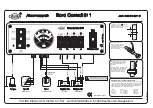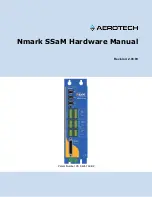
17
BOSCH PERFORMANCE LINE
Bicycle Owner’s Manual
17
fastener do not emboss the surfaces of the dropouts, the
tension is insufficient. Open the lever; turn the tension
adjusting nut clockwise a quarter turn; then try again.
(8) If you disengaged the brake quick-release
mechanism in 3. c. (2) above, re-engage it to restore
correct brake pad-to-rim clearance.
(9) Spin the wheel to make sure that it is centered in
the frame and clears the brake pads; then squeeze the
brake lever and make sure that the brakes are operating
correctly.
B. Seat post cam action clamp
Some bikes are equipped with a cam action seat post
binder. The seat post cam action binder works exactly like
the traditional wheel cam action fastener (Section 4.A.2)
While a cam action binder looks like a long bolt with a
lever on one end and a nut on the other, the binder uses
an over-center cam action to firmly clamp the seat post
(see fig. 8a).
WARNING: Riding with an improperly tightened seat
post can allow the saddle to turn or move and cause
you to lose control and fall. Therefore:
1. Ask your dealer to help you make sure you know how
to correctly clamp your seat post.
2. Understand and apply the correct technique for
clamping your seat post.
3. Before you ride the bike, first check that the seat post
is securely clamped.
Adjusting the seat post cam action mechanism
The action of the cam squeezes the seat collar around
the seat post to hold the seat post securely in place. The
amount of clamping force is controlled by the tension
adjusting nut. Turning the tension adjusting nut clockwise
while keeping the cam lever from rotating increases
clamping force; turning it counterclockwise while keeping
the cam lever from rotating reduces clamping force. Less
than half a turn of the tension adjusting nut can make the
difference between safe and unsafe clamping force.
WARNING: Especially if components (seat post,
frame) made of composites like carbon fibre are in
use, never overtighten the seat post clamp!
Composites and carbon fibre require a different clamping
force. Read the manufacturers manual for correct use.
WARNING: The full force of the cam action is needed
to clamp the seat post securely. Holding the nut
with one hand and turning the lever like a wing nut
with the other hand until everything is as tight as you can
get it will not clamp the seat post safely.
WARNING: If you can fully close the cam lever
without wrapping your fingers around the seat post
or a frame tube for leverage, and the lever does not
leave a clear imprint in the palm of your hand, the tension
is insufficient. Open the lever; turn the tension adjusting
nut clockwise a quarter turn; then try again.
C. Brakes
There are three general types of bicycle brakes: rim
brakes, which operate by squeezing the wheel rim
between two brake pads; disc brakes, which operate by
squeezing a hub-mounted disc between two brake pads;
and internal hub brakes. All three can be operated by
way of a handlebar mounted lever. On some models of
bicycle, the internal hub brake is operated by pedaling
backwards. This is called a Coaster Brake and is described
in Appendix C.
WARNING:
1. Riding with improperly adjusted brakes, worn
brake pads, or wheels on which the rim wear mark is
visible or unvisible because of rim wear is dangerous and
can result in serious injury or death.
2. Applying brakes too hard or too suddenly can lock up
a wheel, which could cause you to lose control and fall.
Sudden or excessive application of the front brake may
pitch the rider over the handlebars, which may result in
serious injury or death.
3. Some bicycle brakes, such as disc brakes (fig. 11)
and linear-pull brakes (fig. 12), are extremely powerful.
Take extra care in becoming familiar with these brakes
and exercise particular care when using them.
4. Some bicycle brakes are equipped with a brake
force modulator, a small, cylindrical device through which
the brake control cable runs and which is designed to
provide a more progressive application of braking force. A
modulator makes the initial brake lever force more gentle,
progressively increasing force until full force is achieved.
If your bike is equipped with a brake force modulator,
take extra care in becoming familiar with its performance
characteristics. Some brake force modulators are
adjustable. If you don’t like the feel of your brakes, ask
your dealer about adjusting the brake force modulation.
5. Disc brakes can get extremely hot with extended use.
Be careful not to touch a disc brake until it has had plenty
of time to cool.
6. See the brake manufacturer’s instructions
for operation and care of your brakes, and for when
brake pads must be replaced. If you do not have the
manufacturer’s instructions, see your dealer or contact the
brake manufacturer.
7. If replacing worn or damaged parts, use only
manufacturer-approved genuine replacement parts.
Содержание bosch performance series
Страница 1: ...1 BOSCH PERFORMANCE LINE MANUAL GAZELLE WITH BOSCH PERFORMANCE LINE SYSTEM ...
Страница 71: ...37 BOSCH PERFORMANCE LINE ...
Страница 72: ...38 GAZELLE MANUAL ...
Страница 73: ...39 BOSCH PERFORMANCE LINE ...
Страница 74: ...ROYAL DUTCH GAZELLE N V Wilhelminaweg 8 6951 BP Dieren The Netherlands ...
















































